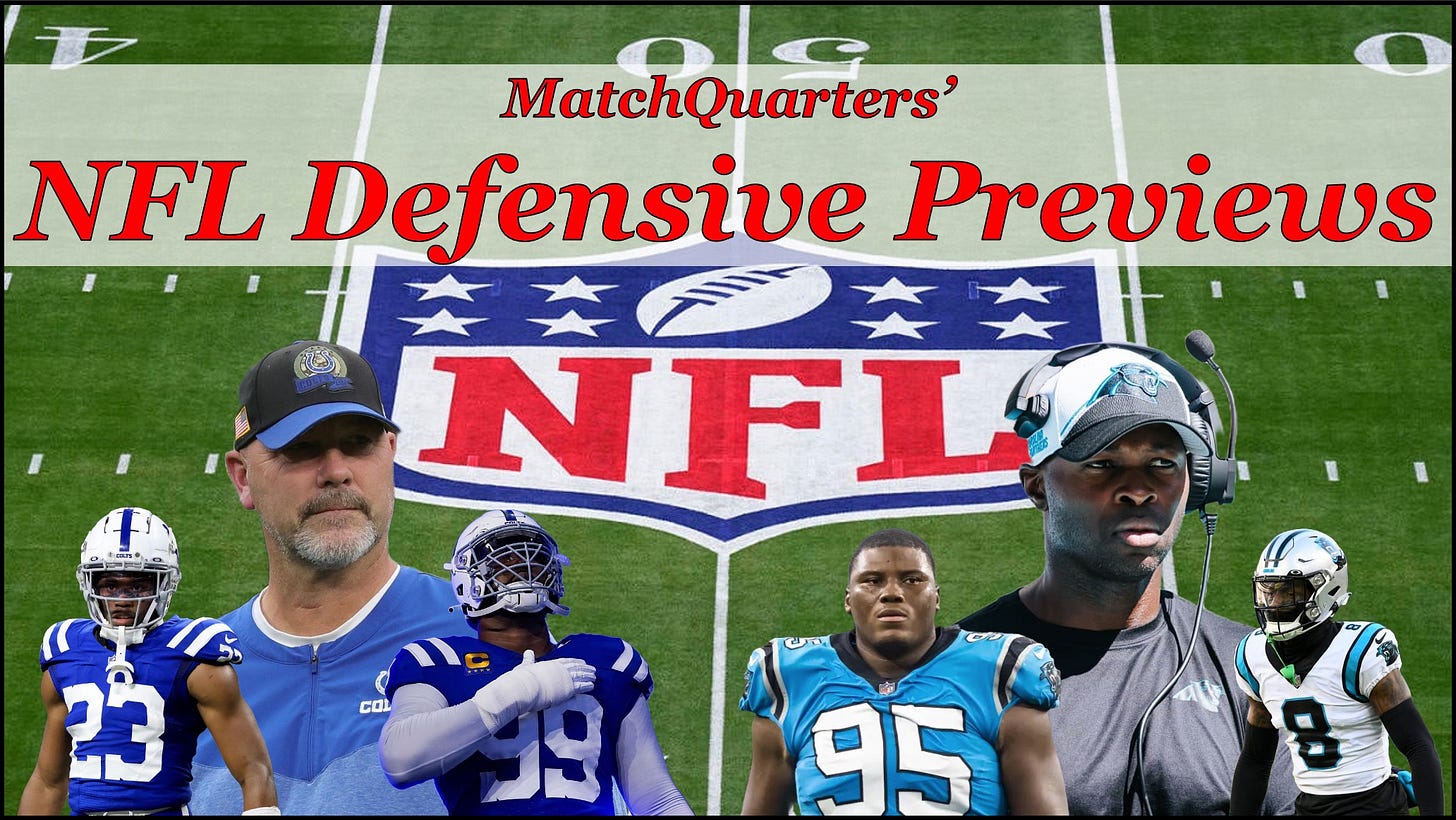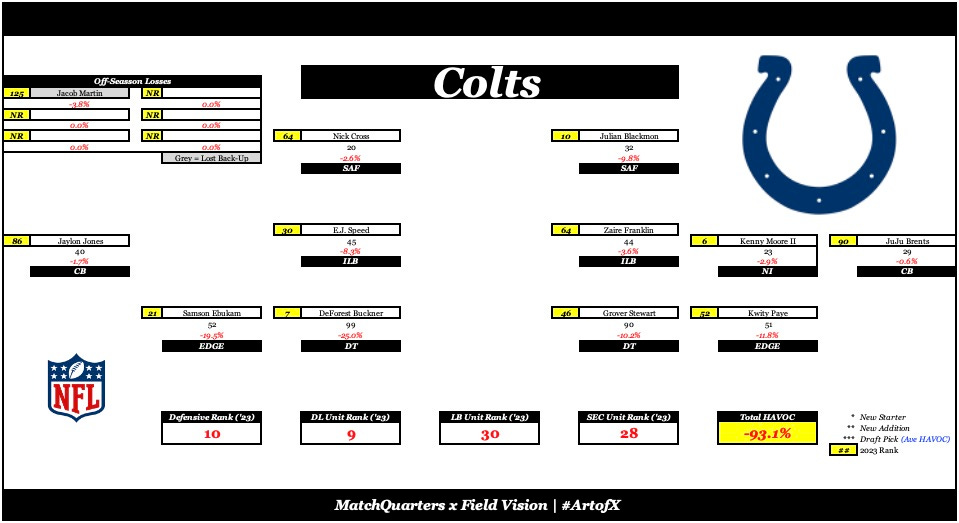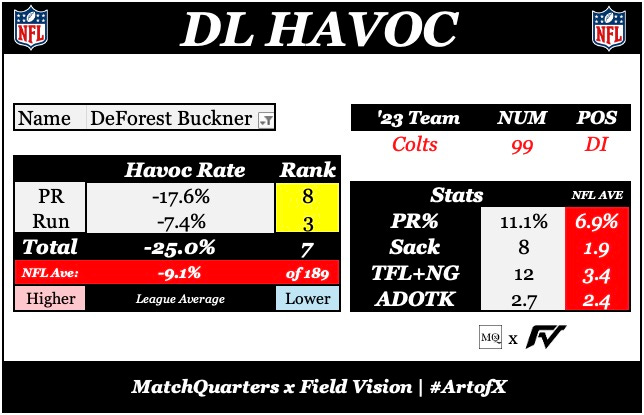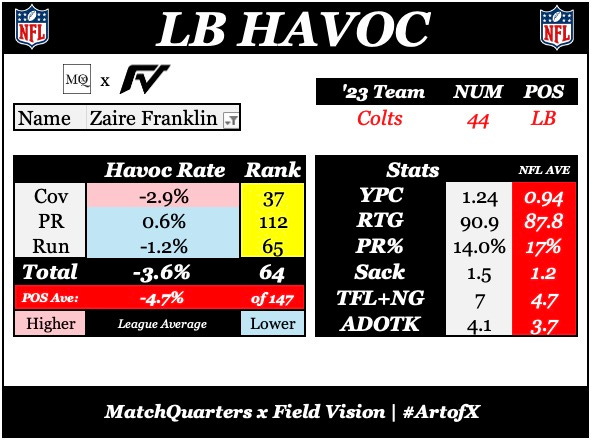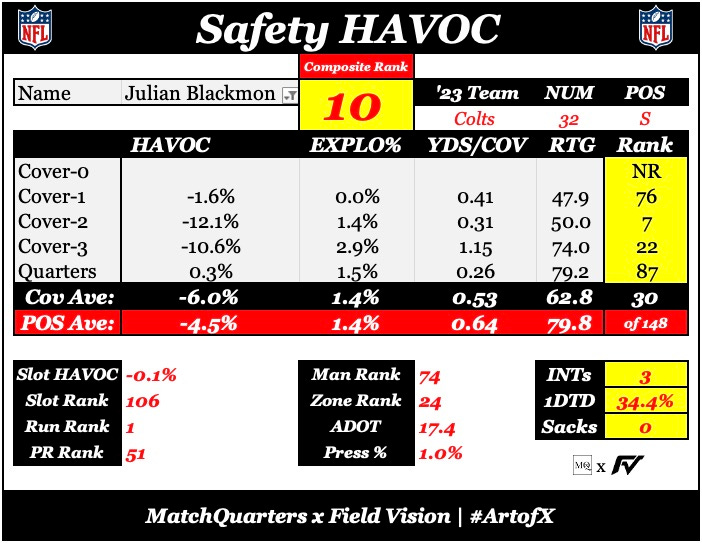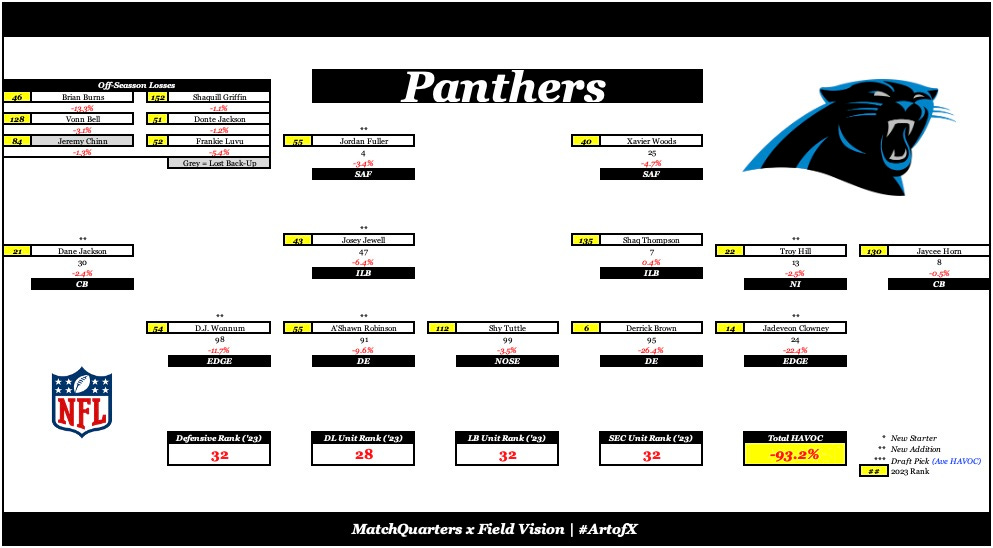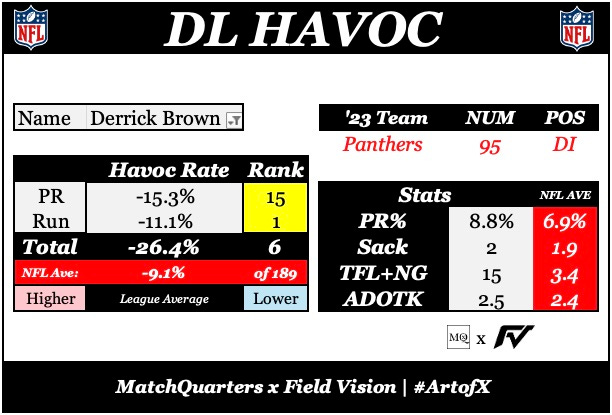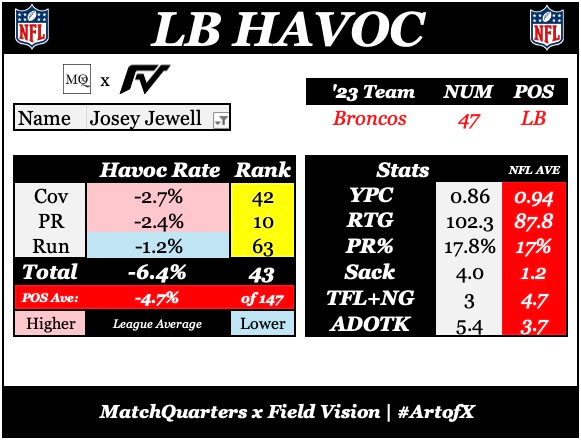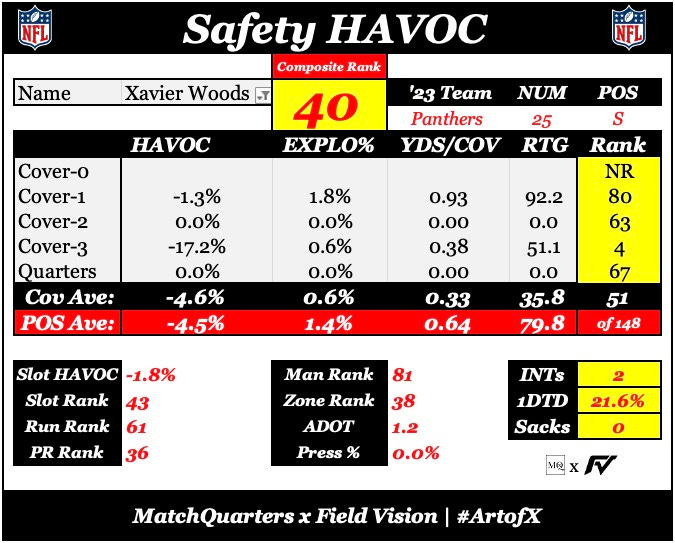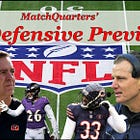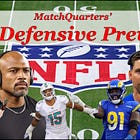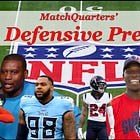MatchQuarters' NFL Season Previews: The Indianapolis Colts and Carolina Panthers
In true Gus Bradley fashion, the Colts stayed 'static' this offseason, banking that the talent is already there. In Carolina, the Panthers overhauled the defense, bringing in former Evero disciples.
Each week leading up to the season, I will review the roster, schemes, and outlook for each defense in the NFL. I have a depth chart for every team with their 2023 Field Vision Sports HAVOC rankings and scores. Projected rookie starters will receive the league average HAVOC for that position. Notable losses are located in the upper left-hand corner. Click on the picture to expand for a better look.
What is HAVOC? I wanted to create a metric that better understood how defenders play within their scheme. For the D-line and LBs, it is pretty straightforward. Can you fit the run and create a pass rush? For LBs and some Edges, coverages have also been added.
In the secondary, it can get complicated. Not every team runs the same amount of coverage. Some, like Dan Quinn, Jim Schwartz, and Gus Bradley, live in a singular style of play, while others, namely Mike Macdonald and Vic Fangio, choose to play a multitude of coverages. I wanted to create a more nuanced way to look at DB play. How are they playing within man and zone schemes, and how diverse is their coverage palate?
Utilizing HAVOC, which is biased towards player and scheme usage, we can better understand how these players are used within the ecosystem they play in. A great example is Seattle’s Riq Woolen, one of the best man coverage CBs in the game but struggles at zone. Team-wise, the Browns have three CBs that excel at man coverage, which suits what DC Schwartz is trying to do.
HAVOC allows us to track free agency signings and paint a better picture of their fit. Should the Commanders, who will play mainly man and 3-match coverages, bring in a zone-centric CB? No, that wouldn’t be wise. Using HAVOC allows us to see how teams are building their rosters defensively. So remember, these numbers show how productive the player was in the scheme they played in last year, which is reflected against their peers in their overall ranking.
» We (Field Vision) will have our finalized HAVOC ratings for the upcoming season in a few weeks, so stay tuned! Click to see the 2024 top-10 Safeties list.
—
Tired of the login dance across multiple investment platforms?
Magnifi streamlines your investment oversight, offering a consolidated view of your finances with real-time analytics. Powered by innovative AI, Magnifi is your one-stop solution for staying ahead.
In an era where coverage disguise and multiplicity are the trendy new topics on defense, the Colts’ defensive coordinator, Gus Bradley, is staying true to himself. The Colts ran the most Cover 3 snaps of any team in the NFL, running the coverage ~55% of the time. The static nature of Bradley’s defenses has become his trademark.
The 4-2-5 Cover 3 defense installed in Indy relies heavily on the front four being disruptors. Though predictable, Bradley has argued since 2009, when he ascended to the DC role in Seattle, that less is more. With less on their plate mentally, the players can focus on their job and play fast.
As a change-up, Bradley has developed an excellent blitz package. Indianapolis doesn’t blitz much. It’s less than 20% of the time. But when they do, the Colts generally send six. Bradley didn’t call one simulated pressure last year.
The Colts didn’t add anyone to the secondary but did draft UCLA’s Edge, Laiatu Latu, in the first Round. He should bring added firepower to the Edge rotation in Indianapolis. Still, with a glaring need in the secondary, pundits were left wondering why the Colts didn’t make a move. Outside Kenny Moore III (Ni6), who mainly plays in the slot, Indianapolis needs another CB.
In reality, the Colts were probably a year early last year. The quarterback position looks to be in great hands, as 1st-round draft pick Anthony Richardson looks like the real deal. The defense played well, but the team needs to improve in the secondary to make a splash.
Houston and Jacksonville look to be heading in positive directions with stable QB play. Tennessee will be in a transition, and the AFC South is likely not to get an extra wildcard slot. All the pressure in Indy will be squarely on Bradley to begin producing at a higher rate, which will be needed to challenge for a playoff spot.
—
» D-Line:
Instead of bringing in a CB this offseason, the Colts focused on adding depth to the defensive line. Outside of iDL DeForest Buckner (DL&), there is no bonafide star on the front line for the Colts. Buckner has been in the league for almost a decade and consistently has been able to produce. Adding depth around him should amplify his skill set.
Besides Buckner, Grover Stewart (DL46) and Raekwon Davis (DL65), who they brought in from Miami, will rotate. Stewart and Buckner were both extended this year. The run defense hasn’t been the issue. If the duo of Stewart and Davis can keep Buckner in one-on-one situations, the defense might be able to give some relief to the secondary.
At Edge, Kwity Paye (ED52) and Samson Ebukan (ED21) will be looking to build on their breakout years. Paye is a former 1st-round draft pick and needs to get into double-digit sacks if he wants a new contract at year’s end. The Colts picked up his 5th Year option this off-season.
All eyes will be on Latu, who is expected to continue his success in the NFL. The former Bruin was one of my favorites coming into the draft this offseason. Latu is a technician who always has a rush plan. He wreaked havoc in the Pac-12 last year.
With rotations inside and outside, the Colts’ D-line should be fresh. Now, they need to produce. Last year, the Colts finished 27th in Pressure Rate. That is not a good stat line with a struggling secondary.
—
» Linebackers:
Since the Colts play a Nickel defense, depth at LB is not a major priority. Zaire Franklin (LB64) has been a solid contributor for the Colts since being drafted seven years ago. He has excellent coverage ability and is decent against the run. Bradley doesn’t ask his LBs to blitz often, so the ability to cover is a premium.
Alongside Franklin is EJ Speed (LB30), who will be the primary Will LB tasked with shadowing TEs. Speed is a coverage LB who fits most of what Bradley is looking for and is more than serviceable against the run.
Finally, Ronnie Harrison Jr. was moved from Safety to LB last year. Though he only played in seven games, he collected two interceptions, one for a touchdown. The added value in coverage should come in handy with different packages and matchups if Bradley wants to expand his role.
—
» Secondary:
The Colts did little to improve their secondary, which tells me they felt pass rush was an issue last year, not talent. The Nickel position is in good hands with Kenny Moore III, one of the better slot defenders in the NFL, who was rewarded with an extension this offseason.
The main issue in the backend is at outside CB. JuJu Brents (CB90) showed promise as a rookie but missed half the year due to injury. The Colts obviously feel he will excel in year two. Opposite Brents is Jaylen Jones (CB86), who will compete with Dallas Flowers, who missed most of the season with an Achilles injury. Jaylon Simpson, a 5th-round pick from Auburn, will have ample opportunity to earn playing time. With no real off-season move, the brass in Indy feels this group has something to prove.
The Safety position might be a bright spot in the secondary. Julian Blackmon (S10) is one of the best run-support safeties in the NFL, excelling in zone coverage. Nick Cross (S64) couldn’t hold onto his starting role last year and is running out of time to develop. Behind Blackmon and Cross are Rodney Harrison Jr, who also started 15 games last year, and Ronnie Harrison Jr.
The secondary is a large question mark that appears to be one the Colts feel they have answers to. Outside Blackmon and Moore, there are large question marks, and players are still trying to solidify their roles. If the secondary can gel, and Cross and Brents come into their own, the potential is there to raise the level of the defense from the middle-class ranks.
—
Unique Insights for Professionals, Proven predictions for fans. Football's Premier Predictive Analytics Platform. Click the logo to go directly to the site. And follow along on Twitter/X.
You should know Ejiro Evero. In 2017, Evero got his first big break as the Safeties coach for Sean McVay, where he’d stay until 2021. The departure of Brandon Staley in 2020 allowed him to move up and become the passing game coordinator under Raheem Morris (current Falcons head coach).
In 2022, he became the Defensive Coordinator for Nathaniel Hacket in Denver. Despite the chaos of the ‘22 season, the Broncos' defense was solid. With Hackett's dismissal, Evero chose to leave the Broncos and was picked up by the Panthers to be their DC last season.
Evero, for the past two seasons, has been making lemonade from the lemons he has been dealt. Running the Fangio system can be complex, and Evero has found a way to excel in multiple spots. Denver was 13th in DVOA in ‘22 with little to no offensive support. At one point, they were a top-ten defense.
Tasked again with creating a solid defense that could support a fledgling offense, Evero produced a middle-class passing defense, finishing 16th in DVOA. If you watch the box scores, you probably think Evero is struggling, but watching the film, you can see that the plan is in place: the Panthers need more talent.
Evero runs the Staley version of the Fangio scheme. Like Morris, most of the snaps are played from a two-high shell, but the defense is squarely rooted in Cover 3 as a base. Multiple personnel groupings from a 3-4 are also present. There are large volumes of Penny (5-1) and not a lot of blitzing.
Carolina completely retooled the defense this offseason and gave Evero the necessary bodies to run his style of defense. Seven new faces will most likely start in Week 1. Most have direct ties to Evero, too.
A’Shawn Robinson (DL55) was brought in from the Giants and has experience in this system, playing for the Rams from ‘20-’22. LB Josey Jewell (LB43) may be the most critical pickup this offseason, as he will be tasked with leading the defense and most likely that solo ‘backer in the Penny package. Finally, the secondary got two former Rams in Troy Hill (Ni25) and Jordan Fuller (S55).
—
» D-Line:
Derrick Brown (DL6) got a massive contract this offseason that was well deserved. Though pass rushing is a premium, Brown is one of the best run-stuffing interior D-linemen in the NFL. With more talent along the line, this will only free up Brown and garner more pass-rush stats.
A’Shawn Robinson is another monster in the run game, finishing 4th overall in Run HAVOC for iDL. The duo of Brown and Robinson should make it difficult for most teams to attack the edges of the box. Inside, Shy Tuttle will play Nose. Evero’s system doesn’t require a dynamic Nose but is more of a workhorse that takes up gaps. Tuttle can do that.
With two monsters inside at the DE spot, the goal is to unleash the Edges and amply a pass rush. Carolina struggled last year to find consistency on the premier of the box, finishing 31st in Pressure Rate. The Panthers are looking to fix that problem with the edition of DJ Wonnum (ED54) and Jadeveon Clowney (ED14).
The five-man front is designed to create one-on-ones for the D-line. With two iDL that will most likely require help blocking, that frees up the Edges to attack the QB. Heading into the season, the primary question mark along the D-line will be the production of the two main Edges.
Clowney is coming off a career year in which he garnered 9.5 sacks. Still, at age 31, Carolina is taking a chance on a player who has never shown consistency. Opposite Clowney, Wonnum has questions as well. His eight sacks are tied for his career best, but like Clowney, he has shown inconsistency.
One wildcard will be former 1st-round draft pick K’Lavon Chaisson (ED106). Chaisson was never able to produce in Jacksonville, garnering five sacks in four years. He will get an opportunity to revamp his career, and the Panthers need depth at Edge.
—
» Linebackers:
Jewell will join Shaq Thompson, who has been with the team since ‘15. Gone is Frankie Luvu (LB52), who gave the team some firepower when blitzing. Jewell and Thompson are a solid duo, and both are tackling machines. Jewell will most likely be looked to replace Luvu’s blitzing ability.
With the Panthers' offseason moves this year, the hope is that the front can keep these two clean. The LB position is not a priority in this scheme, but going and getting Jewell, someone who intimately understands this scheme should pay dividends during the season. If Thompson can regain his play after a lost season in ‘23, the Panthers have the makings of an excellent front seven.
—
» Secondary:
The two remaining starters from ‘23 are CB Jaycee Horn (CB130) and Safety Xavier Woods (S40). Horn has struggled to find the field consistently, missing 29 of 51 games. The Panthers have already picked up his fifth-year option, but the former 1st-Rounder must start producing. The talent is there, and with year two in the same system, the hope is he finally plays to his potential.
Woods has found a home in Carolina. Last year was his most productive by far in his career, and similar to Horn, the continuity of scheme will hopefully amplify his play. Woods excelled last year in Cover 3, so you can see why the Panthers see him as a critical piece of their defense.
Similar to the D-line, the entire secondary has been revamped. Former Rams CB Troy Hill, Safety Jordan Fuller, and Safety Nick Scott (S104) have been brought in to add depth. Fuller and Woods will most likely get the nod to start. Dane Jackson (CB69) was brought in from Buffalo to compete for the starting job opposite Horn. Hill can play outside, so in Base, look for Hill and Jackson to compete for that starting role.
More Season Previews:
—
—
© 2024 MatchQuarters | Cody Alexander | All rights reserved.


